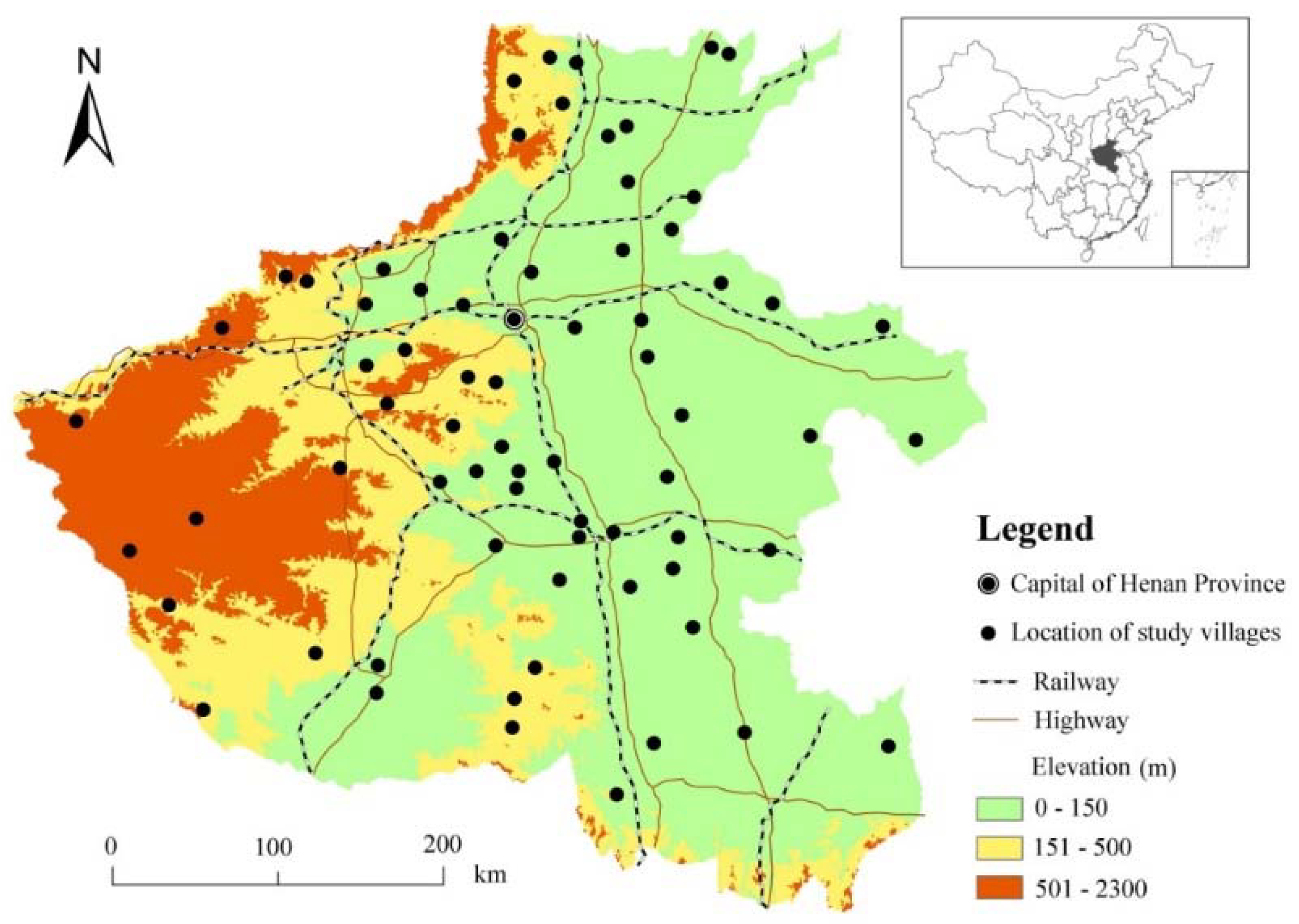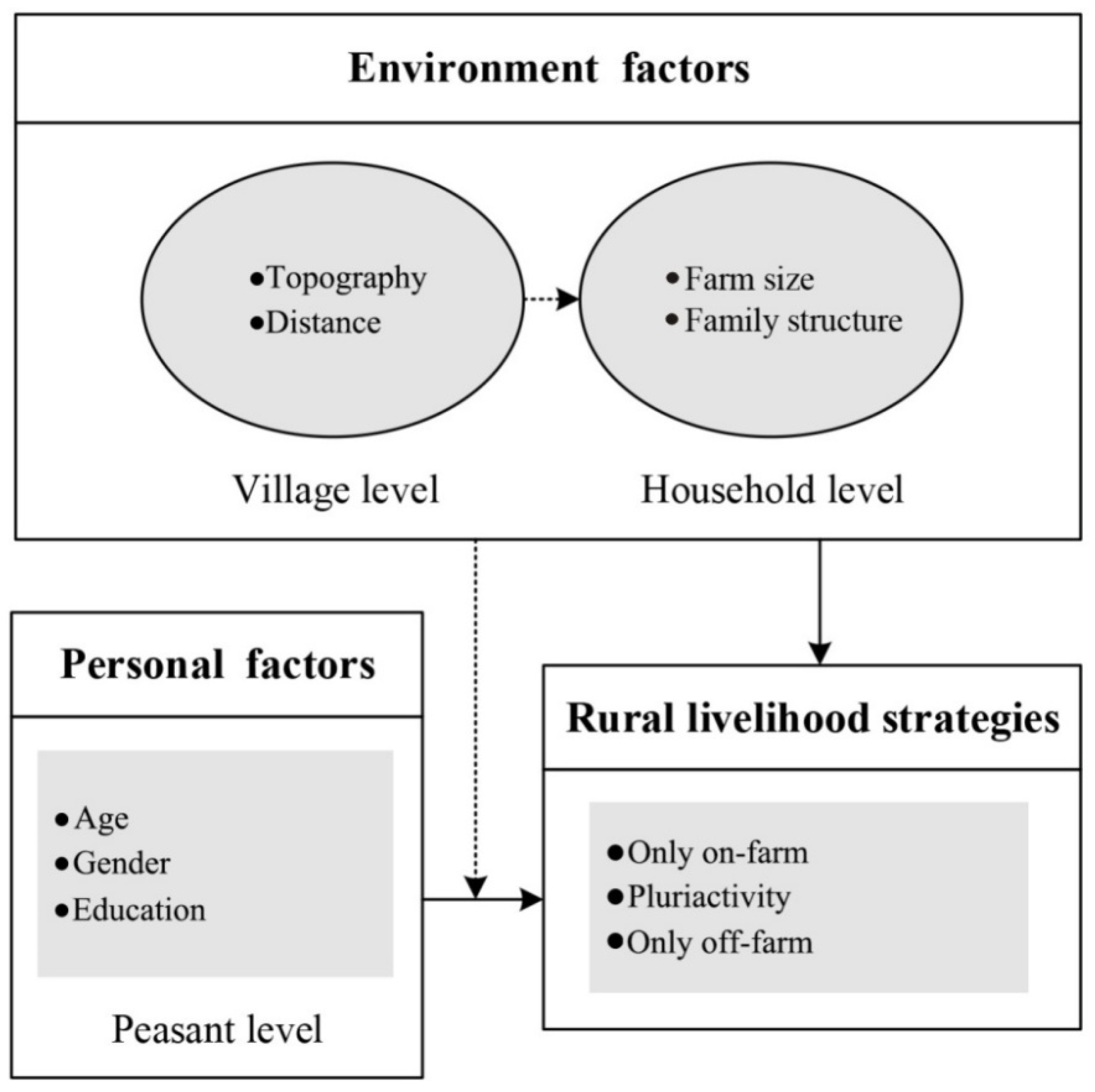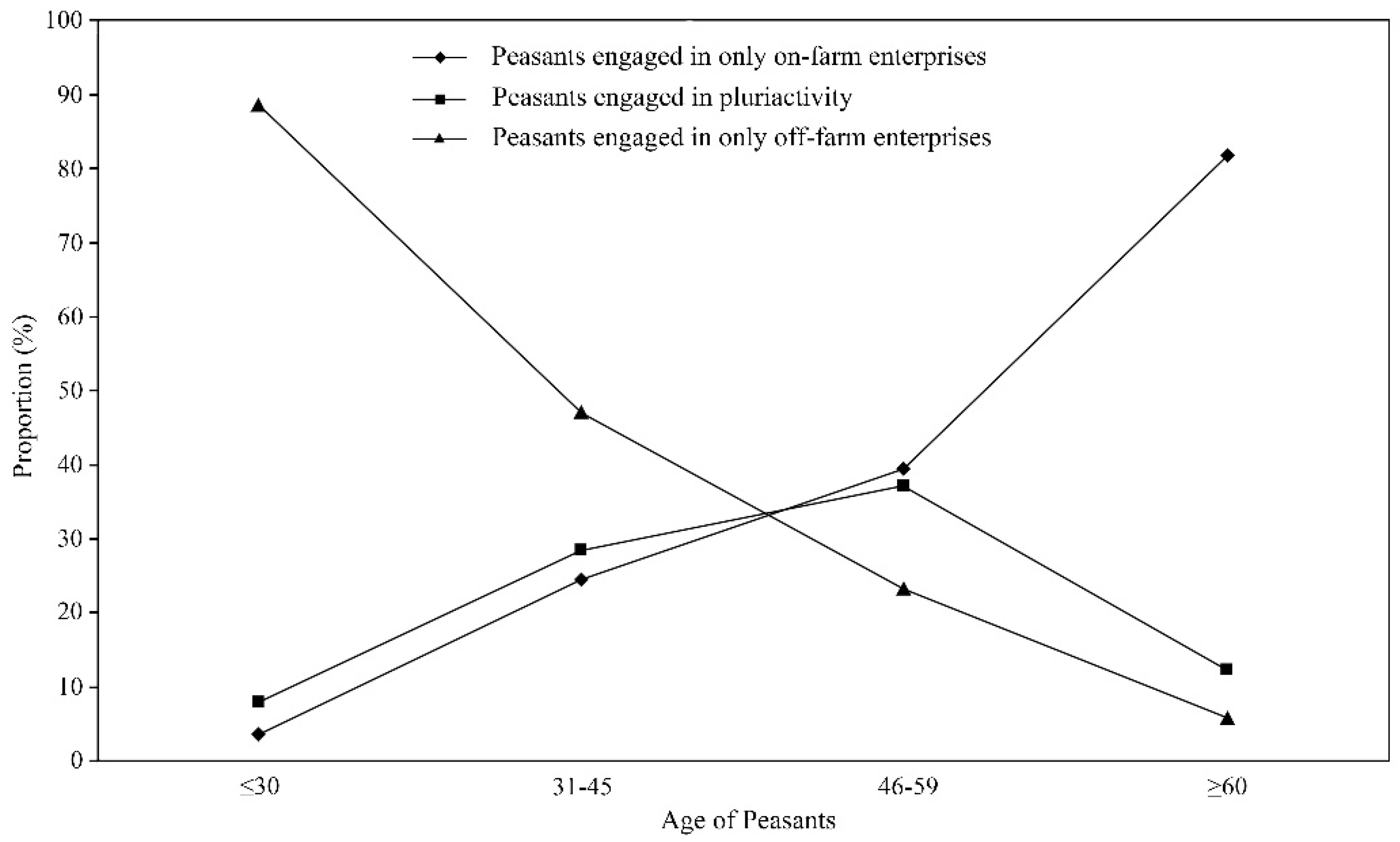Multilevel Modeling of Rural Livelihood Strategies from Peasant to Village Level in Henan Province, China
Abstract
1. Introduction
2. Materials and Methods
2.1. Study Area
2.2. Data Collection
2.3. Literature Review and Theoretical Framework
2.4. Multi-Level Model Specification
3. Results
3.1. Outcomes of the Unconditional Models
3.2. Outcomes of the Conditional Models
4. Discussion
5. Conclusions
Author Contributions
Funding
Conflicts of Interest
References
- United Nations. The Millennium Development Goals Report 2015; United Nations: New York, NY, USA, 2015. [Google Scholar]
- Benjamin, D.; Brandt, L.; Giles, J. The evolution of income inequality in rural China. Econ. Dev. Cult. Chang. 2005, 53, 796–824. [Google Scholar] [CrossRef]
- Ravallion, M.; Chen, S. China’s (uneven) progress against poverty. J. Dev. Econ. 2007, 82, 1–42. [Google Scholar] [CrossRef]
- National Bureau of statistics of the People’s Republic of China (NBSPRC). China Statistical Yearbook 2014; NBSPRC: Beijing, China, 2014. (In Chinese)
- National Bureau of statistics of the People’s Republic of China (NBSPRC). China Statistical Yearbook 2017; NBSPRC: Beijing, China, 2017. (In Chinese)
- Tsui, K.Y. Factor decomposition of Chinese rural income inequality: New methodology, empirical findings, and policy implications. J. Comp. Econ. 1998, 26, 502–528. [Google Scholar]
- Bramall, C. Research report: The quality of China’s household income survey. China Q. 2001, 167, 689–705. [Google Scholar] [CrossRef]
- Knight, J. China’s evolving inequality. J. Chin. Econ. Bus. Stud. 2017, 15, 307–323. [Google Scholar] [CrossRef]
- Barham, B.; Boucher, S. Migration, remittances and inequality: Estimating the net effects of migration on income distribution. J. Dev. Econ. 1998, 55, 307–331. [Google Scholar] [CrossRef]
- Elbers, C.; Lanjouw, P. Intersectoral transfer, growth, and inequality in rural Ecuador. World Dev. 2001, 29, 481–496. [Google Scholar] [CrossRef]
- Babatunde, R.O.; Olagunju, F.I.; Fakayode, S.B.; Adejobi, A.O. Determinants of participation in off-farm employment among small-holder farming households in Kwara State, Nigeria. Prod. Agric. Technol. 2010, 6, 1–14. [Google Scholar]
- He, R.W.; Li, G.Q.; Liu, S.Q.; Xu, D.D.; Li, L.N. A literature review of China’s rural poverty governance from the perspective of sustainable livelihood. China Popul. Resour. Environ. 2017, 27, 69–85. (In Chinese) [Google Scholar]
- Department for International Development (DFID). Sustainable Livelihoods Guidance Sheets; DFID: London, UK, 2000; pp. 68–125.
- Ranis, G.; Stewart, F. Rural nonagricultural activities in development: Theory and application. J. Dev. Econ. 1993, 40, 75–101. [Google Scholar] [CrossRef]
- Van den Berg, M.M.; Hengsdijk, H.; Wolf, J.; Van Ittersum, M.K.; Wang, G.H.; Roetter, R.P. The impact of increasing farm size and mechanization on rural income and rice production in Zhejiang Province, China. Agric. Syst. 2007, 94, 841–850. [Google Scholar] [CrossRef]
- Ye, J.Z.; Wang, Y.H.; Long, N. Farmer initiatives and livelihood diversification: From the collective to the market economy in rural China. J. Agrar. Chang. 2009, 9, 175–203. [Google Scholar] [CrossRef]
- Yi, Z.F.; Wong, G.; Cannon, C.H.; Xu, J.C.; Beckschäfer, P.; Swetnam, R.D. Can carbon-trading schemes help to protect China’s most diverse forest ecosystems? A case study from Xishuangbanna, Yunnan. Land Use Policy 2014, 38, 646–656. [Google Scholar] [CrossRef]
- Zhang, L.; Kono, Y.; Kobayashi, S.; Hu, H.; Zhou, R.; Qin, Y. The expansion of smallholder rubber farming in Xishuangbanna, China: A case study of two Dai villages. Land Use Policy 2015, 42, 628–634. [Google Scholar] [CrossRef]
- Qiao, J.J.; Wang, H.F. Spatial-temporal variation of village-level economy development based on characteristic planting in less developed regions: A case study of Shilipu Village in Henan Province. Hum. Geogr. 2012, 2, 82–86. (In Chinese) [Google Scholar]
- Xu, J.W.; Chen, Y.; Qiao, J.J. Study on agricultural production location of households by field research—A case of Wugou Village, Gongyi City, Henan Province. Henan Sci. 2010, 28, 501–504. (In Chinese) [Google Scholar]
- Ge, X.P.; Luan, J. Effect of non-farm employment of farmer on agricultural production. Mod. Agric. Sci. Technol. 2012, 7, 11–13. (In Chinese) [Google Scholar]
- Liu, Y.; Li, Y. Revitalize the world’s countryside. Nature 2017, 548, 275–277. [Google Scholar] [CrossRef] [PubMed]
- Ellis, F. Rural Livelihoods and Diversity in Developing Countries; Oxford University Press: Oxford, UK, 2000. [Google Scholar]
- Qian, Z.H. Whether off-farm employment will inevitably lead to agricultural land transfer. Chin. Rural Econ. 2008, 10, 13–21. (In Chinese) [Google Scholar]
- Allison, E.H.; Ellis, F. The livelihoods approach and management of small-scale fisheries. Mar. Policy 2001, 25, 377–388. [Google Scholar] [CrossRef]
- Barbieri, A.F.; Pan, W.K. People, land, and context: Multilevel determinants of off-farm employment in the Ecuadorian Amazon. Popul. Space Place 2013, 19, 558–579. [Google Scholar] [CrossRef]
- Zhang, L.; Kono, Y.; Hua, X.B.; Zheng, L.; Zhou, R. Understanding peasants’ adoption decisions for new cash crops: Evidence from Xishuangbanna in tropical China. Probl. Sustain. Dev. 2017, 12, 99–108. [Google Scholar]
- Li, E.; Coates, K.; Li, X.; Ye, X.; Leipnik, M. Analyzing Agricultural Agglomeration in China. Sustainability 2017, 9, 313. [Google Scholar] [CrossRef]
- Zhu, L.; Liu, Y.S. Analysis of the impact of off-farm employment of agricultural labor on grain production in Shandong province and Henan province. Agric. Sci. Technol. 2012, 13, 1609–1615. [Google Scholar]
- Henan Provincial Bureau of Statistics (HPBS); Henan Survey Organization National Bureau of Statistics Information Network (HSONBSIN). Statistical Communique on National Economics and Social Development of Henan 2012; HPBS: Zhengzhou, China, 2012.
- De Sherbinin, A.; VanWey, L.K.; McSweeney, K.; Aggarwal, R.; Barbieri, A.; Henry, S.; Hunter, L.M.; Twine, W.; Walker, R. Rural household demographics, livelihoods and the environment. Glob. Environ. Chang. 2008, 18, 38–53. [Google Scholar] [CrossRef] [PubMed]
- Liu, Z.; Liu, L. Characteristics and driving factors of rural livelihood transition in the east coastal region of China: A case study of suburban Shanghai. J. Rural Stud. 2016, 43, 145–158. [Google Scholar] [CrossRef]
- Niehof, A. The significance of diversification for rural livelihood systems. Food Policy 2004, 29, 321–338. [Google Scholar] [CrossRef]
- Barrett, C.B.; Reardon, T.; Webb, P. Nonfarm income diversification and household livelihood strategies in rural Africa: Concepts, dynamics, and policy implications. Food Policy 2001, 26, 315–331. [Google Scholar] [CrossRef]
- Huffman, W.E. Farm and off-farm work decisions: The role of human capital. Rev. Econ. Stat. 1980, 62, 14–23. [Google Scholar] [CrossRef]
- Mishra, A.K.; Goodwin, B.K. Farm income variability and the supply of off-farm labor. Am. J. Agric. Econ. 1997, 79, 880–887. [Google Scholar] [CrossRef]
- Beyene, A.D. Determinants of off-farm participation decision of farm households in Ethiopia. Agrekon 2008, 47, 140–161. [Google Scholar] [CrossRef]
- Saqalli, M.; Jourdren, M.; Maestripieri, N.; Guillerme, S.; Maire, E.; Soulileuth, B.; Latsachach, K.; Sounyafong, P.; Tammahuxsa, L.; Sengtaheuanghoung, O.; et al. Backward waters, modern waters: Perception based regional mapping territory uses and water-related sanitary stakes in Luang Phabang area (Lao PDR). Appl. Geogr. 2015, 60, 184–193. [Google Scholar] [CrossRef]
- Diebolt, C.; Hippe, R. Remoteness equals backwardness? Human capital and market access in the European regions: Insights from the long run. Educ. Econ. 2018, 26, 285–304. [Google Scholar] [CrossRef]
- Fang, Y.; Fan, J.; Shen, M.; Song, M. Sensitivity of livelihood strategy to livelihood capital in mountain areas: Empirical analysis based on different settlements in the upper reaches of the Minjiang River. Ecol. Indic. 2014, 38, 225–235. [Google Scholar] [CrossRef]
- De Janvry, A.; Sadoulet, E. Income strategies among rural households in Mexico: The role of off-farm activities. World Dev. 2001, 29, 467–480. [Google Scholar] [CrossRef]
- Osborne, J.W. Advantages of hierarchical linear modeling. Pract. Assess. Res. Eval. 2000, 7, 2–7. [Google Scholar]
- Woltman, H.; Feldstain, A.; MacKay, J.C.; Rocchi, M. An introduction to hierarchical linear modeling. Tutor. Quant. Methods Psychol. 2012, 8, 52–69. [Google Scholar] [CrossRef]
- Zhang, Y.; Li, X.; Song, W. Determinants of cropland abandonment at the parcel, household and village levels in mountain areas of China: A multi-level analysis. Land Use Policy 2014, 41, 186–192. [Google Scholar] [CrossRef]
- Overmars, K.P.; Verburg, P.H. Multilevel modelling of land use from field to village level in the Philippines. Agric. Syst. 2006, 89, 435–456. [Google Scholar] [CrossRef]
- Snijders, T.; Bosker, R. Multilevel Analysis: An Introduction to Basic and Applied Multilevel Analysis; Sage: London, UK, 1999. [Google Scholar]
- Browne, W.J.; Subramanian, S.V.; Jones, K.; Goldstein, H. Variance partitioning in multilevel logistic models that exhibit over-dispersion. J. R. Stat. Soc. A 2005, 168, 599–613. [Google Scholar] [CrossRef]
- Raudenbush, S.W.; Bryk, A.S.; Congdon, R. HLM 6 for Windows, Computer Software; Scientific Software International: Lincolnwood, IL, USA, 2004.
- Zhao, X. Emergence and its conditions in China individualization: Review of correlated theories of individualization. J. Chang’an Univ. 2011, 13, 68–75. (In Chinese) [Google Scholar]
- Qiao, J.; Lee, J.; Ye, X. Spatiotemporal evolution of specialized villages and rural development: A case study of Henan province, China. Ann. Am. Assoc. Geogr. 2016, 106, 57–75. [Google Scholar] [CrossRef]
- Cárdenas Alonso, G.; Nieto Masot, A. Towards Rural Sustainable Development? Contributions of the EAFRD 2007–2013 in Low Demographic Density Territories: The Case of Extremadura (SW Spain). Sustainability 2017, 9, 1173. [Google Scholar] [CrossRef]
- Carter, C.A. China’s agriculture: Achievements and challenges. ARE Update 2011, 14, 5–7. [Google Scholar]
- Xie, H.L.; Wang, P.; Yao, G.R. Exploring the dynamic mechanisms of farmland abandonment based on a spatially explicit economic model for environmental sustainability: A case study in Jiangxi Province, China. Sustainability 2014, 6, 1260–1282. [Google Scholar] [CrossRef]
- Yan, J.Z.; Zhang, Y.L.; Hua, X.B.; Yang, L. An explanation of labor migration and grain output growth: Findings of a case study in eastern Tibetan Plateau. J. Geogr. Sci. 2016, 26, 484–500. [Google Scholar] [CrossRef]
- Rozelle, S.; Guo, L.; Shen, M.; Hughart, A.; Giles, J. Leaving China’s farms: Survey results of new paths and remaining hurdles to rural migration. China Q. 1999, 158, 367–393. [Google Scholar] [CrossRef]
- An, S.W.; Fan, X.S. Analysis of Peasants’ livelihood strategy and its influencing factors based on income source—A case study of Henan Province. Econ. Surv. 2018, 35, 29–34. (In Chinese) [Google Scholar]




| Variable Name | Description | Min. | Max. | Mean | SD |
|---|---|---|---|---|---|
| Dependent variables (Peasant level n = 1621) | |||||
| Only on-farm | 1 if the peasant only engages in on-farm enterprises; 0 if otherwise | 0 | 1 | N/A | N/A |
| Pluriactivity | 1 if the peasant engages in both on-farm and off-farm enterprises; 0 if otherwise | 0 | 1 | N/A | N/A |
| Only off-farm | 1 if the peasant only engages in off-farm enterprises; 0 if otherwise | 0 | 1 | N/A | N/A |
| Independent variables | |||||
| Level 1—Peasant level (n = 1621) | |||||
| Age | Age of peasants | 17 | 84 | 44.00 | 13.51 |
| Gender | 1 if the gender of the peasant is male; 0 if the gender of the peasant is female | 0 | 1 | N/A | N/A |
| Education | Educational years of peasants in school | 0 | 19 | 7.62 | 3.44 |
| Level 2—Household level (n = 691) | |||||
| Farm size | Household-owned farmland area (ha) | 0 | 1.53 | 0.32 | 0.19 |
| Family structure | 1 if the family has members over 70 and (or) under six years of age; 0 otherwise | 0 | 1 | N/A | N/A |
| Level 3—Village level (n = 70) | |||||
| Topography | 1 if the village is located in a mountainous area; 0 if the village is located on a plain | 0 | 1 | N/A | N/A |
| Distance | The distance from the village to the nearest urban area (km) | 1 | 100 | 20.53 | 17.80 |
| Variables | Engaged in Only On-Farm | Engaged in Pluriactivity | Engaged in Only Off-Farm | |||
|---|---|---|---|---|---|---|
| a (1) Unconditional Model | b (1) Conditional Model | a (2) Unconditional Model | b (2) Conditional Model | a (3) Unconditional Model | b (3) Conditional Model | |
| Fixed effects | ||||||
| Level 1—Peasant level | ||||||
| Intercept | −0.756 *** | −1.197 *** | −1.224 *** | −1.369 *** | −0.339 *** | −0.527 *** |
| Age | 0.110 *** | 0.031 *** | −0.127 *** | |||
| Gender | −1.791 *** | 1.240 *** | 0.442 ** | |||
| Education | −0.086 *** | −0.007 | 0.113 *** | |||
| Level 2—Household level | ||||||
| Farm size | 0.015 | −0.028 | 0.028 | |||
| Family structure | −0.004 | 0.123 | −0.190 | |||
| Level 3—Village level | ||||||
| Topography | 0.196 | −0.015 | −0.164 | |||
| Distance | 0.007 | −0.021 ** | 0.011 | |||
| Random effects | ||||||
| Level 2—Household level | ||||||
| Var () | 0.000 | 0.330 * | 0.000 | 0.268 | 0.000 | 0.475 |
| 0.000 | 0.077 | 0.000 | 0.062 | 0.000 | 0.095 | |
| Level 3—Village level | ||||||
| Var () | 0.461 *** | 0.664 *** | 0.657 *** | 0.785 *** | 0.605 *** | 1.257 *** |
| 0.123 | 0.155 | 0.166 | 0.181 | 0.155 | 0.250 | |
© 2018 by the authors. Licensee MDPI, Basel, Switzerland. This article is an open access article distributed under the terms and conditions of the Creative Commons Attribution (CC BY) license (http://creativecommons.org/licenses/by/4.0/).
Share and Cite
Zhang, L.; Liao, C.; Zhang, H.; Hua, X. Multilevel Modeling of Rural Livelihood Strategies from Peasant to Village Level in Henan Province, China. Sustainability 2018, 10, 2967. https://doi.org/10.3390/su10092967
Zhang L, Liao C, Zhang H, Hua X. Multilevel Modeling of Rural Livelihood Strategies from Peasant to Village Level in Henan Province, China. Sustainability. 2018; 10(9):2967. https://doi.org/10.3390/su10092967
Chicago/Turabian StyleZhang, Le, Chuanqing Liao, Huan Zhang, and Xiaobo Hua. 2018. "Multilevel Modeling of Rural Livelihood Strategies from Peasant to Village Level in Henan Province, China" Sustainability 10, no. 9: 2967. https://doi.org/10.3390/su10092967
APA StyleZhang, L., Liao, C., Zhang, H., & Hua, X. (2018). Multilevel Modeling of Rural Livelihood Strategies from Peasant to Village Level in Henan Province, China. Sustainability, 10(9), 2967. https://doi.org/10.3390/su10092967






